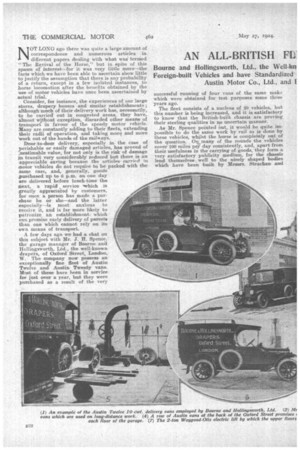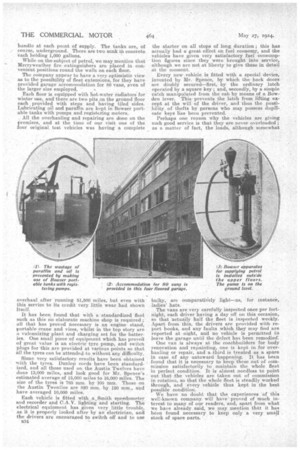AN ALL-BRITISH PUJ 3F DELIVERY VANS.
Page 18

Page 19

Page 20

If you've noticed an error in this article please click here to report it so we can fix it.
Bourne and Hollingsworth, Ltd., the WellForeign-built Vehicles and have Standardized Austin Motor Co., Ltd., and I ;us, of Oxford Street, have Disposed of Their t. and 16-cwt. Vans, with Chassis Built by the Messrs. Strachan and Brown.
NOT LONG ago there was quite a large amount of correspondence and numerous articles in different papers dealing with what was termed " The Revival of the Horse," but in spite of this spasm of interest—for it was very little more—the facts which we have been able to ascertain show little to justify the assumption that there is any probability of a return, except in n few isolated instances, to horse locomotion after the benefits obtained by the use of motor vehicles have once been ascertained by actual trial.
Consider, for instance, the experiences of our large stores, drapery houses and similar establishments ; although much of their delivery work has, necessarily, to be carried out in congested areas, they have, almost without exception, discarded other means of transport in favour of the speedy motor vehicle. Many are constantly adding to their fleets, extending their radii of operation, and taking more and more Work out of the .hands of the railways.
Door-to-door delivery, especially in the case of perishable or easily damaged articles, has proved of ,nestimable value, 'for not only is the risk of damage in transit very considerably reduced but there is an .appreciable saving because the articles carried in motor Vehicles do not require to be packed with the Same care, and, generally, goods ,purchased: up to 6 p.m, on one day are delivered before lunch-time Elm next, a rapid service 'which is greatly appreciated by customers, for once a person has made a purchase he or she—and the latter especially—is most anxious to receive it, and is far more likely to patronize an establishment: which can promise early delivery of parcels than one which cannot rely on its own means of transport. .
A few days ago we had a chat on this subject with Mr. J. H. Spence, the garage manager of Bourne and Hollingsworth, Ltd., the well-known drapers, of Oxford Street, London, W. The company now Possess an exceptionally fine fleet of Austin Twelve and Austin Twenty vans. Most of these have been in service for just over a year, but they were purchased as a result. of the very successful running of four vans of the same make, which were obtained for test purposes some three years ago.
The fleet consists or a nucleus of 29 vehicles, but this number is being increased, and it is satisfactory to know that the British-built chassis are proving their sterling qualities in no uncertain manner. As Mr. Spence pointed Out, it would be quite impossible to do the same work by rail as is done by these vehicles, whilst the horse is completely out of the question. On many of the rounds the vehicles cover 100 miles per day consistently, and, apart from their usefulness in the carrying of goods, they form a very satisfactory publicity medium, for the chassis lend themselves well to the nicely shaped bodies which have been built by Messrs. Strach.an and
Brown. The vans are panelled in metal with interior wood slats to prevent damage, and have domed and curved roofs, the provision of a rail permitting light articles to be carried thereon. Fairly high doors, a double windscreen and folding side curtains give the driver adequate weather protection, and, apart from this, the vehicles are kept in fine condition, both with regard to their mechanism and bodywork.
All the short-distance work within a radius of approximately five miles is performed by the Austin Twelve vans, but both these and the Austin Twenties are employed for the longer circuits. Taking examples at random, one van operating in a district which includes Weybridge averages 97 to 100 miles per day, but on some occasions does as many as 120. and the average time taken to perform the-journey can be judged when we learn that this van leaves at 8.45 a.m. and returns between 5 p.m. and 6 p.m. Another van operating in the neighbourhood of Ealing does from 100 to 114 miles per day ; it also starts at 8.45 a.m, and returns any time between 4.30 p.m. and 6.40 p.m., something hice 75 deliveries being made on each journey.
The system of operation is quite simple. The drivers start work at 8.30 a.m., and the long-distance vans are sent to the 'back of the Oxford Street premises for loading, which is so expedited that it usually does not occupy longer than 10 minutes. The goods are sent up from the despatch department by lifts to the street level, where they are loaded into the vans by the porters, one of whom accompanies each driver. The porters are thoroughly conversant with the routes on which they are employed ; they are thus able to load the vehicles in such a manner-that the articles first required are the -last to be put in.
The general scheme is to get rid of the long-distance vehicles first, after which attention is paid to those on local work.
Last June the company took possession of their new garage, which they had built in Wells Mews. This building has been arranged on the most modern lines, and special facilities have been provided to enable the vehicles to enter or leave with the utmost despatch. The size of the area available has necessitated the building of four stones, and access to these is given by a large 2-ton Waygood-Otis electric lift. On each of the upper floors is a turntable by which the vans can be turned to any direction, thus saving a considerable amount of m'anseuvring. The bed of each turntable is most carefully drained by means of piping -which is brought through the floor and runs along the ceiling of the story below.
An unusual feature is the provision of a Bowser petrol supply pump which feeds not only to the ground level but also the upper stories. On each floor the operating mechanism, filter and hose are astrried on a metal platform built on to the outer walls; the actual pump is on the ground level, but it is operated by the movement of a handle at each point of supply. The tanks are, of course, underground. There are two sunk in concrete each holding 1,000 gallons.
While on the subject of petrol, we may mention that Merryweather fire -extinguishers are placed in convenient positions round the walls on each floor.
The company appear to have a very optimistic view as to the possibility of fleet extensions, for they have provided garage accommodation for 80 vane, _even of the larger size employed.
Each floor is equipped with hot-water radiators for winter use, and there are two pits on the ground floor each .provided with steps and having tiled sides. Lubricating oil and paraffin are kept in Bowser portable tanks with pumps and registering meters.
, All the overhauling and repairing are done on the premises, and at the time of our . visit one of the four original, test vehicles was having a complete overhaul after running 51,500 miles, but even with this Service to its credit very little wear had shown It has been found that with a ,standardized fleet such as this no -elaborate machine shop is required ; all that has proved necessary is an engine stand, portable crane and vices, whilst in the top story are a vulcanizing plant and charging set for the batter.. ies. One Small piece of equipment which has proveil of great value is an electric tyre pump, and switch plugs for this. are provided at various points so that all the tyres can be attended.to_without any difficulty.
Some very satisfactory results have been obtained with the tyres. Dunlop cords have been standardized, and all those used on the Austin Twelves have done 13,000 miles, and look good for Mr. Spence's estimated average of 15,000 miles to 16,000 miles. The size of the tyres is 765 mm. by 105 mm. Those on the Austin Twenties are 820 mm. by 120 mm., and have averaged 10,000 miles.
Each vehicle is fltied With ,a, Smith speedometer and recorder and C.A.V. lighting and starting. The electrical equipment has given very little trouble. as it is properly looked after by an electrician, and the drivers are encouraged to switch off and to use B31
the .starter on all stops of long, duration ; this has actually had a great effect on fuel economy, and the vehicles have given very satisfactory fuel consumpe Lion figures since they were brought into service, although we are not at liberty to give these in detail at the moment.
Every new vehicle is fitted with a. special .device, invented by Mr. Speriee, by which the back doors ave doubly secured—first, by the ordinary latch operated by a square key ; and, secondly, by a simple catch manipulated from the cab by means of a Bowden lever. Thisprevents the hitch from lifting except at the will of the driver, and thus the poss-ibility of thefts by persons who may possess duplicate keys Has been prevented: .
Perhaps one reason why the vehicles are giving such good service is that they are never overloaded ; as a matter of fact, the load, although somewhat
bulky, are comparatiVely light—as, -for instance, ladies' hats.
The vans are very carefully inspected once per fortnight, each driver having a day off on this occasion, so that actually half the fleet is inspected weekly. Apart from this the drivers are provided with report books, and any faults which they may find are reported at -night, and no vehicle is permitted i0 leave the garage until the defect has been rernedieLf. One van is always at the coaehbuilders for body renovation and repainting, one is kept in for overhauling or repair, and a third is treated as a spare in case of any untoward happening. It has been -found that it is necessary to keep these out of commission satisfactorily. to maintain the whole fleet in perfect condition. it is almost needless to point out that the vehicles are taken out of commission in rotatiou, so-that the whole fleet is steadily worked through, and every vehicle thus kept in the best possible condition.
We have no doubt that the experiences of this well-known company will have' proved of much interest to many of our readers, and, apart from what WE have already.. said, we may. mention that. it has been found necessary to keep only a very small stock of spare riarts..






























